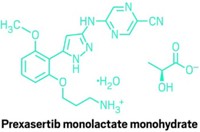Advertisement
Grab your lab coat. Let's get started
Welcome!
Welcome!
Create an account below to get 6 C&EN articles per month, receive newsletters and more - all free.
It seems this is your first time logging in online. Please enter the following information to continue.
As an ACS member you automatically get access to this site. All we need is few more details to create your reading experience.
Not you? Sign in with a different account.
Not you? Sign in with a different account.
ERROR 1
ERROR 1
ERROR 2
ERROR 2
ERROR 2
ERROR 2
ERROR 2
Password and Confirm password must match.
If you have an ACS member number, please enter it here so we can link this account to your membership. (optional)
ERROR 2
ACS values your privacy. By submitting your information, you are gaining access to C&EN and subscribing to our weekly newsletter. We use the information you provide to make your reading experience better, and we will never sell your data to third party members.
Synthesis
Chemical Aerobics
Kilogram-scale O2 oxidations safely carried out in a flow reactor
by Stephen K. Ritter
July 5, 2010
| A version of this story appeared in
Volume 88, Issue 27

In a “green” academic-industry collaboration, Shannon S. Stahl and coworkers of the University of Wisconsin, Madison, and Martin D. Johnson and Matthew H. Yates at Eli Lilly & Co. teamed up to create a safe and scalable continuous-flow reactor system for palladium-catalyzed aerobic oxidation reactions. The development should broaden the use of molecular oxygen in place of environmentally undesirable oxidizing reagents such as permanganate currently used for oxidations in pharmaceutical production (Green Chem., DOI: 10.1039/c0gc00106f).
The synthetic scope and utility of palladium-catalyzed aerobic oxidations for pharmaceutical process chemistry has increased substantially over the past decade, Stahl notes. Because O2 is inexpensive and readily available, it’s commonly used as an oxidant in large-scale commodity chemical production, he says. But aerobic oxidations have been avoided in the pharmaceutical industry primarily because most companies lack expertise in O2 safety engineering, Stahl adds.

In 2007, Stahl and Yates connected at a conference and began discussing possible solutions. The researchers realized they could address the safety challenge if they could combine Stahl’s palladium reaction chemistry with Lilly’s process engineering.
The outcome is a modular flow reactor system with a small footprint—easily transported on a truck between Stahl’s lab in Wisconsin and Lilly’s facility in Indianapolis—in which stainless steel tube reactors of different diameters and lengths can be interchanged to accommodate gram- to kilogram-scale reactions.
The researchers used oxidations of alcohols to aldehydes and ketones to demonstrate the functionality of the reactor. The system includes reservoirs for the substrate and homogeneous palladium pyridine catalyst solution, as well as O2 and N2 tanks. The O2 is diluted in the inert N2 (8% O2 in N2), ensuring that the combination of O2 and flammable organic reagents doesn’t become explosive.
The Wisconsin-Lilly team typically carried out reactions at 100 °C at 30 psi of O2. Reactions lasting up to about five hours provided better than 90% yield, generating only water as a by-product and permitting catalyst recovery.
“This work shows the possibilities for transferring lab-scale results of catalytic reactions in a straightforward manner to production scale,” comments Norbert Kockmann, who is responsible for continuous-flow processes and microreactor technology at Swiss specialty chemical firm Lonza. “This type of closed handling of a potentially explosive mixture can dramatically increase process safety,” Kockmann adds.
Green oxidations are one of the goals of the ACS Green Chemistry Institute’s Pharmaceutical Roundtable, a group of pharmaceutical industry representatives with a mission to identify and overcome common drug discovery and process chemistry challenges. GlaxoSmithKline’s Conchita Jimenez-Gonzalez, who cochairs the roundtable, says the Wisconsin-Lilly aerobic oxidation represents “a very good piece of work” that responds to one of the roundtable’s key strategic areas. “This type of research expands the available options of synthetic chemistry by leveraging engineering and chemistry in an integrated fashion,” she says.





Join the conversation
Contact the reporter
Submit a Letter to the Editor for publication
Engage with us on Twitter